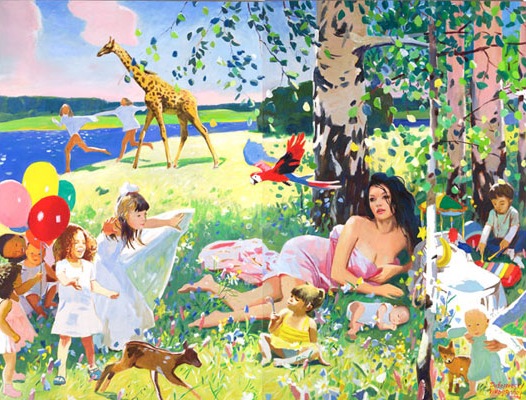This is an archive of the ArtCat Zine, 2007-2009. Please visit our new project, IDIOM.
"The New People" at Deitch Projects

The New People Are Already Here
Vladimir Dubossarsky and Alexander Vinogradov
Deitch Projects - 76 Grand St, New York NY
Russia is a country of many contradictions. The rich live lavishly, adorned with Chanel and BMW SUVs that often come with a driver and a body guard. The poor, on the other hand, live in dire straits because the vestiges of a dead regime following the dissipation of the Soviet Union left them with nothing more than pathetic pensions that are not a far leap from Soviet bread lines and empty shelves in department stores. In fact, according to the Forbes list of the richest men in the world, number three, following Bill Gates and Warren Buffet, is the Russian mogul Roman Abramovich. Fine, he is actually number 11, but at the age of 39, his net worth is $18.2 billion. And yet the tight fists of the neo-dictators, who rule this multifarious and expansive land, seek to rid the country of criminal activity that has been so conducive to the "oligarch" status the wealthy men of business have acquired. The less fortunate masses view former president, now prime minister Putin's Czar-like persona with the same ambivalence that marks this nation; after all, while he has tacitly extinguished any potential opposing voices (read: killed off all the journalists who dare to speak any brazen truth), he has equally quelled the fires of mafia wars that raged in Russia through the 1990s. With business management and democratic politics under their belt, elite Russians have turned to art as the category of knowledge that can buy them a certain level of sophistication. In fact, Sotheby's recently shipped a collection of works to Bavrikha, a high end mall of sorts on the outskirts of Moscow, where the oligarchs buy their Gucci and their Fendi, and now, can browse the de Koonings, Hirsts and Warhols.
At this point, dear reader, you are probably wondering what the hell this diatribe on the sad state of affairs in the Russian Federation has to do with the Deitch show, and rightfully so. In a land of rampant consumerism and obsession with a newfound capitalism dream, Russian artists Alexander Vinogradov and Vladimir Dubossarsky express the hyper-real contemporary culture of Russia today through the trained eye of the figurative painter, laden with the traditions of Russian 19th and 20th century art. Artistic expression is as crucial to Russian culture as Vodka and rye bread. From the classically trained artists of the 19th century whose expressions of idyllic peasants and their religious simplicity filled state museums, to the 20th century visions of communist ideals through stately impressions of its totalitarian leaders whose images equally filled state museums, come the duo of Vinogradov and Dubossarsky who met at Communist camp and whose exhibition The New People Are Already Here expresses precisely the contradictory nature of contemporary Russia. For instance, in Summer Bubbles, a busty brunette clad in a pink blanket lounges around a lake, amidst the trunks of several birch, the motherland's quintessential tree, while blissful children frolic about, play with musical instruments, and so on. A giraffe in the distance runs along while little deer observe the angelic children. The scene evokes the mystical devotion of the Russian soul as much as the new materialist devotion of that same Russian soul, through the multitude of possessions littering the composition, juxtaposed with old-time fairy tale imagery, and the single, emphatically sexualized figure in an otherwise innocuous scene.
In another work, Lullabye, a naked woman breast feeds her child who is covered in a light blue halo, just like all the other multi ethnic children in the depicted scene. We can see the constructs of a stage, calling our attention to the artifices of the composition. The backdrop is the glowing specter of a bygone communist Moscow by night, which serves as an antithetical reminder of the loud modern metropolis that still holds within it remnants of an old world order with its newfound mystical charm and possibilities of a new people, as the title of the show implies. In The Beatles, a young hottie with a mini skirt holds in her arms a pink teddy bear, while children dressed in bright colors sing and dance to plastic instruments; angels carry a toy castle while the serene azure blue of a distant lake echoes with promises of dream-like stature. All in all, the works are grand in scale and imagery and follow the great traditions laid down by the previous masters of technique and cultural perspicacity. Long lines are no stranger to the Russian people. This holds true for bread, bananas and beer as much as it does for generations of artists who serve as cultural avatars. Thus, Vinogradov and Dubossarsky have staked their claim to the cultural, and soon enough, financial riches their motherland has to offer. They have managed to capture the nuanced coexistence of two pertinent realities: the idyllic Russia of mystical and earthly wonders and the Russia of brazen wealth, new vision and visual economy, all with its many inherent contradictions.
ZINE
HOME
TIPS / COMMENTS
CATEGORIES
CONTRIBUTORS
- Greg Afinogenov
- B. Blagojevic
- Adda Birnir
- Susannah Edelbaum
- Julie Fishkin
- Paddy Johnson
- Jessica Loudis
- Christopher Reiger
- Andrew Robinson
- Peter J. Russo
- Blythe Sheldon
- S.C.Squibb
- Hrag Vartanian
